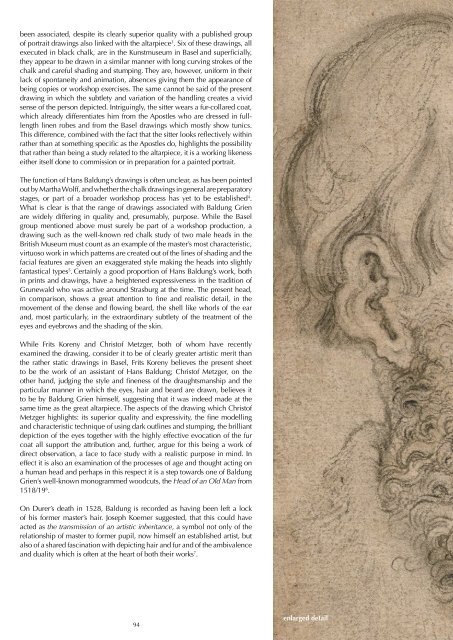You also want an ePaper? Increase the reach of your titles
YUMPU automatically turns print PDFs into web optimized ePapers that Google loves.
een associated, despite its clearly superior quality with a published group<br />
of portrait drawings also linked with the altarpiece 3 . Six of these drawings, all<br />
executed in black chalk, are in the Kunstmuseum in Basel and superficially,<br />
they appear to be drawn in a similar manner with long curving strokes of the<br />
chalk and careful shading and stumping. They are, however, uniform in their<br />
lack of spontaneity and animation, absences giving them the appearance of<br />
being copies or workshop exercises. The same cannot be said of the present<br />
drawing in which the subtlety and variation of the handling creates a vivid<br />
sense of the person depicted. Intriguingly, the sitter wears a fur-collared coat,<br />
which already differentiates him from the Apostles who are dressed in fulllength<br />
linen robes and from the Basel drawings which mostly show tunics.<br />
This difference, combined with the fact that the sitter looks reflectively within<br />
rather than at something specific as the Apostles do, highlights the possibility<br />
that rather than being a study related to the altarpiece, it is a working likeness<br />
either itself done to commission or in preparation for a painted portrait.<br />
The function of Hans Baldung’s drawings is often unclear, as has been pointed<br />
out by Martha Wolff, and whether the chalk drawings in general are preparatory<br />
stages, or part of a broader workshop process has yet to be established 4 .<br />
What is clear is that the range of drawings associated with Baldung Grien<br />
are widely differing in quality and, presumably, purpose. While the Basel<br />
group mentioned above must surely be part of a workshop production, a<br />
drawing such as the well-known red chalk study of two male heads in the<br />
British Museum must count as an example of the master’s most characteristic,<br />
virtuoso work in which patterns are created out of the lines of shading and the<br />
facial features are given an exaggerated style making the heads into slightly<br />
fantastical types 5 . Certainly a good proportion of Hans Baldung’s work, both<br />
in prints and drawings, have a heightened expressiveness in the tradition of<br />
Grunewald who was active around Strasburg at the time. The present head,<br />
in comparison, shows a great attention to fine and realistic detail, in the<br />
movement of the dense and flowing beard, the shell like whorls of the ear<br />
and, most particularly, in the extraordinary subtlety of the treatment of the<br />
eyes and eyebrows and the shading of the skin.<br />
While Frits Koreny and Christof Metzger, both of whom have recently<br />
examined the drawing, consider it to be of clearly greater artistic merit than<br />
the rather static drawings in Basel, Frits Koreny believes the present sheet<br />
to be the work of an assistant of Hans Baldung; Christof Metzger, on the<br />
other hand, judging the style and fineness of the draughtsmanship and the<br />
particular manner in which the eyes, hair and beard are drawn, believes it<br />
to be by Baldung Grien himself, suggesting that it was indeed made at the<br />
same time as the great altarpiece. The aspects of the drawing which Christof<br />
Metzger highlights: its superior quality and expressivity, the fine modelling<br />
and characteristic technique of using dark outlines and stumping, the brilliant<br />
depiction of the eyes together with the highly effective evocation of the fur<br />
coat all support the attribution and, further, argue for this being a work of<br />
direct observation, a face to face study with a realistic purpose in mind. In<br />
effect it is also an examination of the processes of age and thought acting on<br />
a human head and perhaps in this respect it is a step towards one of Baldung<br />
Grien’s well-known monogrammed woodcuts, the Head of an Old Man from<br />
1518/19 6 .<br />
On Durer’s death in 1528, Baldung is recorded as having been left a lock<br />
of his former master’s hair. Joseph Koerner suggested, that this could have<br />
acted as the transmission of an artistic inheritance, a symbol not only of the<br />
relationship of master to former pupil, now himself an established artist, but<br />
also of a shared fascination with depicting hair and fur and of the ambivalence<br />
and duality which is often at the heart of both their works 7 .<br />
94<br />
enlarged detail
















